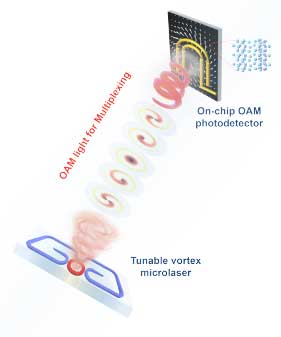| May 18, 2020 | |
Engineers develop first tunable, chip-based 'vortex microlaser' and detector(Nanowerk News) As computers get more powerful and connected, the amount of data that we send and receive is in a constant race with the technologies that we use to transmit it. Electrons are now proving insufficiently fast and are being replaced by photons as the demand for fiber optic internet cabling and data centers grow. |
|
| Though light is much faster than electricity, in modern optical systems, more information is transmitted by layering data into multiple aspects of a light wave, such as its amplitude, wavelength and polarization. Increasingly sophisticated "multiplexing" techniques like these are the only way to stay ahead of the increasing demand for data, but those too are approaching a bottleneck. We are simply running out of room to store more data in the conventional properties of light. | |
| To break through this barrier, engineers are exploring some of light's harder-to-control properties. Now, two studies from the University of Pennsylvania's School of Engineering and Applied Science have shown a system that can manipulate and detect one such property known as the orbital angular momentum, or OAM, of light. Critically, they are the first to do so on small semiconductor chips and with enough precision that it can be used as a medium for transmitting information. | |
 |
|
| Vortex lasers are named for the way light spirals around their axis of travel, thanks to a property known as orbital angular momentum, or OAM. Different OAM “modes” correspond to the direction and spacing of those spirals, and given a sensitive enough laser and detector, could be another property in which information could be transmitted. | |
| The matched pair of studies, published in the journal Science, was done in collaboration with researchers at Duke University, Northeastern University, the Polytechnic University of Milan, Hunan University and the U.S. National Institute of Standards and Technology. | |
| One study ("Tunable topological charge vortex microlaser"), led by Liang Feng, assistant professor in the departments of Materials Science and Engineering and Electrical and Systems Engineering, demonstrates a microlaser which can be dynamically tuned to multiple distinct OAM modes. The other ("Photocurrent detection of the orbital angular momentum of light"), led by Ritesh Agarwal, professor in the Department of Materials Science and Engineering, shows how a laser's OAM mode can be measured by a chip-based detector. Both studies involve collaborations between the Agarwal and Feng groups at Penn. | |
| Such "vortex" lasers, named for the way their light spirals around their axis of travel, were first demonstrated by Feng with quantum symmetry-driven designs in 2016. However, Feng and other researchers in the field have thus far been limited to transmitting a single, pre-set OAM mode, making them impractical for encoding more information. On the receiving end, existing detectors have relied on complex filtering techniques using bulky components that have prevented them from being integrated directly onto a chip, and are thus incompatible with most practical optical communications approaches. | |
| Together, this new tunable vortex micro-transceiver and receiver represents the two most critical components of a system that can enable a way of multiplying the information density of optical communication, potentially shattering that looming bandwidth bottleneck. | |
| The ability to dynamically tune OAM values would also enable a photonic update to a classic encryption technique: frequency hopping. By rapidly switching between OAM modes in a pre-defined sequence known only to the sender and receiver, optical communications could be made impossible to intercept. | |
| "Our findings mark a large step towards launching large-capacity optical communication networks and confronting the upcoming information crunch," says Feng. | |
| In the most basic form of optical communication, transmitting a binary message is as simple as representing 1s and 0s by whether the light is on or off. This is effectively a measure of the light's amplitude -- how high the peak of the wave is -- which we experience as brightness. As lasers and detectors become more precise, they can consistently emit and distinguish between different levels of amplitude, allowing for more bits of information to be contained in the same signal. | |
| Even more sophisticated lasers and detectors can alter other properties of light, such as its wavelength, which corresponds to color, and its polarization, which is the orientation of the wave's oscillations relative to its direction of travel. Many of these properties can be set independently of each other, allowing for increasingly dense multiplexing. | |
| Orbital angular momentum is yet another property of light, though it is considerably harder to manipulate, given the complexity of the nanoscale features necessary to generate it from computer-chip-sized lasers. Circularly polarized light carries an electric field that rotates around its axis of travel, meaning its photons have a quality known as spin angular momentum, or SAM. Under highly controlled spin-orbit interactions, SAM can be locked or converted into another property, orbital angular momentum, or OAM. | |
| The research on a dynamically tunable OAM laser based on this concept was led by Feng and graduate student Zhifeng Zhang. | |
 |
|
| Asymmetry in optical “pumping” from the control arms on either side of the microring laser allow for resulting light’s OAM to be “tuned” to different modes. A new orbital photogalvanic effect is responsible for detecting the OAM of light. | |
| In this new study, Feng, Zhang and their colleagues began with a "microring" laser, which consists of a ring of semiconductor, only a few microns wide, through which light can circulate indefinitely as long as power is supplied. When additional light is "pumped" into the ring from control arms on either side of the ring, the delicately designed ring emits circularly polarized laser light. Critically, asymmetry between the two control arms allows for the SAM of the resulting laser to be coupled with OAM in a particular direction. | |
| This means that rather than merely rotating around the axis of the beam, as circularly polarized light does, the wavefront of such a laser orbits that axis and thus travels in a helical pattern. A laser's OAM "mode" corresponds to its chirality, the direction those helices twist, and how close together its twists are. | |
| "We demonstrated a microring laser that is capable of emitting five distinct OAM modes," Feng says. "That may increase the data channel of such lasers by up to five times." | |
| Being able to multiplex the OAM, SAM and wavelength of laser light is itself unprecedented, but not particularly useful without a detector that can differentiate between those states and read them out. | |
| In concert with Feng's work on the tunable vortex microlaser, the research on the OAM detector was led by Agarwal and Zhurun Ji, a graduate student in his lab. | |
| "OAM modes are currently detected through bulk approaches such as mode sorters, or by filtering techniques such as modal decomposition," Agarwal says, "but none of these methods are likely to work on a chip, or interface seamlessly with electronic signals." | |
| Agarwal and Ji built upon their previous work with Weyl semimetals, a class of quantum materials that have bulk quantum states whose electrical properties can be controlled using light. Their experiments showed that they could control the direction of electrons in those materials by shining light with different SAM onto it. | |
| Along with their collaborators, Agarwal and Ji drew on this phenomenon by designing a photodetector that is similarly responsive to different OAM modes. In their new detector, the photocurrent generated by light with different OAM modes produced unique current patterns, which allowed the researchers determine the OAM of light impinging on their device. | |
| "These results not only demonstrate a novel quantum phenomenon in the light-matter interaction," Agarwal says, "but for the first time enable the direct read-out of the phase information of light using an on-chip photodetector. These studies hold great promise for designing highly compact systems for future optical communication systems." | |
| Next, Agarwal and Feng plan to collaborate on such systems. By combining their unique expertise to fabricate on-chip vortex microlasers and detectors that can uniquely detect light's OAM, they will design integrated systems to demonstrate new concepts in optical communications with enhanced data transmission capabilities for classical light and upon increasing the sensitivity to single photons, for quantum applications. This demonstration of a new dimension for storing information based on OAM modes can help create richer superposition quantum states to increase information capacity by a few orders of magnitude. |
| Source: University of Pennsylvania | |
|
Subscribe to a free copy of one of our daily Nanowerk Newsletter Email Digests with a compilation of all of the day's news. |
